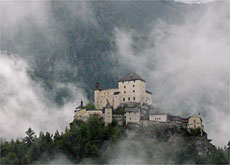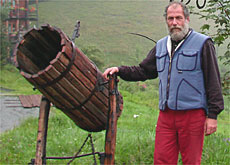Mouthwash king haunts Tarasp Castle

Tarasp Castle has seen bishops, Tyrolean Counts and Holy Roman Emperors pass through its doors.
But it was the inventor of the world’s first antiseptic mouthwash who really left his mark on the medieval fortress.
And some believe Karl August Lingner’s ghost still haunts its dark corridors.
“Lingner died in 1916, just two weeks before he finished restoring and renovating the castle,” explains castle custodian, Jon Fanzun. “He never saw the castle when it was finished, and he never heard its organ. That’s very tragic.”
The castle organ installed by Lingner is played for every visitor to Tarasp Castle. The music is carried into the concert hall from speakers hidden behind wood panelling and cupboards.
Even the organ is located behind a secret door. The sudden eerie first strains of the instrument have an unsettling effect.
Mouthwash mogul
Lingner made his fortune inventing and marketing the world’s first antiseptic mouthwash, Odol, in 1893.
And what else would a self-made man at the start of the 20th century do with his spare millions? Buy a medieval castle, of course.
Furniture plundered
All the better if it had a proud history and a sorry end, having passed through the hands of bishops, counts and emperors before being abandoned and finally having every last stick of its furniture sold or plundered.
Lingner bought the castle for the paltry sum of SFr20,000 in 1900 and then invested a small fortune in its restoration and conversion into a summer residence.
“He came here on holiday and found the castle in a very bad condition, but he fell in love with the area and the castle,” says Fanzun.
Even today, it is hard not to be mesmerised when the castle first comes into view. It dominates the Lower Engadine valley from its perch on top of a rocky hillock.
Stained glass windows
Lingner’s renovation took nine years, during which time the German became a collector, refitting the gutted rooms of the buildings with exquisitely carved Renaissance wood panelling, Flemish tapestries and a remarkable number of stained glass windows – the oldest dating back to the early 16th century.
No one knows the castle or the Lingner collection better than Fanzun. As the third generation of castle custodians, he has spent his entire life exploring its dark halls and secret passageways, and opening and closing its creaky doors.
As he jangles a large key ring while unlocking another door, he speaks of Lingner’s ghost.
“I’m often here in the evening alone. There’s a very strange atmosphere here at that time,” he says.
“I don’t notice anything during the day when I’m showing tourists around, but I have a strange feeling when I’m here in the evening. I once had a dog, and he refused to come here with me after dark.”
Even if Karl August Lingner didn’t live long enough to hear the organ played, its strains are appreciated by its ghost, if indeed, they are not played by the spirit itself.
swissinfo/Dale Bechtel
Open from Christmas to Easter on Tuesdays and Thursdays and daily from June until the middle of October.
Visits are by guided tour only.
There are hotels in the small community of Tarasp-Vulpera but most visitors to the Lower Engadine stay in the neighbouring and much larger resort of Scuol.
There is a frequent postal bus service between the two resorts.
Tarasp Castle was built in the 11th century. It originally belonged to the Tarasp family, and was later owned by the Bishops of Chur and Tyrolean and Austrian royalty.
It was handed over to the newly formed government of the Swiss canton of Graubünden in the early 19th century.
The government did not want to pay for its upkeep so it was sold to a wealthy buyer in 1827. It passed through various hands until 1900, when it was bought by Karl August Lingner.
He paid for its restoration and renovation, which took place between 1907 and 1916.
Since Lingner’s death in 1916, the castle has been owned by the family of the Grand Duke of Hesse and the Rhine, which keep an apartment in the building.

In compliance with the JTI standards
More: SWI swissinfo.ch certified by the Journalism Trust Initiative


You can find an overview of ongoing debates with our journalists here. Please join us!
If you want to start a conversation about a topic raised in this article or want to report factual errors, email us at english@swissinfo.ch.